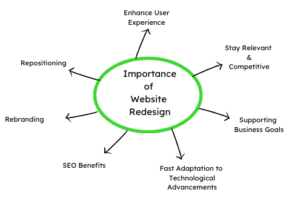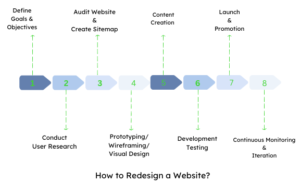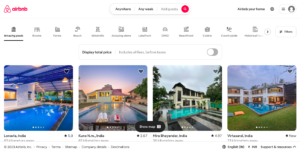Complete Website Redesign Guide Before You Start
In the ever evolving digital landscape, websites have become the virtual storefronts of businesses, the gateways to captivating online experiences. And if your website is not up to the latest designs then website redesign becomes must for you.
As technology advances and user expectations evolve, even the most brilliant websites find themselves at a crossroads – a pivotal moment where the call for change becomes irresistible.
This is why, the need for a website redesign emerges, driven by a powerful desire to defy the ordinary, reimagine possibilities, and create a digital presence that leaves visitors breathless.
If you also feel the same that you need to embrace the winds of change, embark with innovation and creativity to shape your website that will captivate the target audience and influence the SEO ranking factors.
If yes, let us dive into understanding deeply about redesigning a website.
Also Read: What is experience design?
What is Website Redesigning?
Making changes in the website to improve the existing website for its design, structure, and functionality to enhance visual appeal, user experience, and performance of the website.
It involves a comprehensive evaluation and overhaul of various aspects of the website to align it with current trends, technologies, and user expectations.

For website redesign, the designers, developers, and stakeholders collaborate to assess the strengths and weaknesses of the current website and identify areas for improvement.
They then analyse user feedback, study website analytics, and conduct user research to find data on user behaviour and preferences.
Elaborating on the different aspects of website redesigning:
Visual Design:
The visual design of a website plays a crucial role in creating a compelling and aesthetically pleasing user experience. For a visual design revamping, the designers work on website’s overall look, including colour schemes, typography, imagery, and layout. They aim to create a visually appealing and cohesive design that aligns with the brand identity and engages users.
User Experience (UX):
UX is the core of a successful website redesign.For UX improvements, designers work on optimising navigation, simplifying the user interface, improving information architecture, and streamlining the conversion process. The ultimate goal of the designers is to create an engaging, user-friendly experience that fulfils user needs and encourages desired actions.
Content Strategy:
Content is a fundamental component of any website. A redesign often involves reevaluating and refining the content strategy. This includes reviewing existing content, identifying gaps, and creating new, relevant content. A focus is placed on crafting compelling copy, incorporating visual media effectively, and ensuring that the content aligns with the target audience’s needs and expectations.
Responsive Design:
With the growing use of mobile devices, designers must thing of making their website responsive. A website redesign involves optimising its layout and functionality to ensure it adapts seamlessly to different screen sizes and devices.
Responsive design gives a user-friendly experience across desktops, tablets, and smartphones.
Performance and Technical Enhancements:
Website speed and performance play important role for ranking of the website, because a poor load website will have a high bounce rate.
Hence, as part of a redesign, you must consider technical aspects like coding practices, caching, and optimization techniques, are reviewed and enhanced to improve load times and overall performance. You must get new technologies integrated with the upgraded content management system, and implement advanced features and functionalities.
SEO Considerations:
A website redesign provides an opportunity to review and improve search engine optimization (SEO) strategies. This includes conducting keyword research, optimising meta tags, improving site structure for search engine crawlers, and ensuring that the website follows SEO best practices. These optimizations aim to increase organic visibility, drive traffic, and improve the website’s search engine rankings.
Testing and Iteration:
Testing and Iteration is an important part for the designers and developers. They must check the cross-browser compatibility, to ensure the redesigned website functions as intended and provide an optimal user experience. Feedback gathered during testing helps identify any remaining issues or areas for further improvement.
Why Website Redesign is Important?
Website redesign is important as it enhances user experience, keeps businesses relevant and competitive, supports organisational goals, adapts to technological advancements, provides SEO benefits, and facilitates rebranding efforts.
By investing in a website redesign, businesses can improve their online presence, engage users effectively, and achieve their desired outcomes.
These are the reasons which makes website redesigning is important:

Enhancing User Experience:
A website redesign allows for an improved user experience by implementing design and functionality enhancements.
After the thorough analysis of user behaviour and feedback, designers can identify pain points. According to the feedback they can optimise navigation, streamline the user interface, and create a more intuitive and engaging experience.
A positive user experience increases user satisfaction, longer visit durations, higher conversion rates, and improved customer loyalty.
Staying Relevant and Competitive:
Technology and design trends evolve rapidly, and user expectations rise. A website redesign helps businesses stay relevant and competitive in the digital landscape. By incorporating modern design elements, adopting responsive design principles, and leveraging the latest technologies, a redesigned website can better capture users’ attention, differentiate from competitors, and convey a contemporary brand image.
Supporting Business Goals:
A website is a powerful marketing and sales tool for businesses. A redesign provides an opportunity to align the website’s design, content, and functionality with the organisation’s current goals and strategies. Whether the focus is on increasing conversions, generating leads, improving brand awareness, or expanding online presence, a well-executed redesign can support these objectives by optimising the website for desired outcomes.
Adapting to Technological Advancements:
With the constant evolution of web technologies, a website redesign allows businesses to leverage new tools and features that enhance performance and functionality. This includes incorporating faster loading times, implementing improved security measures, integrating social media platforms, leveraging data analytics, and embracing emerging technologies such as chatbots or voice interfaces. Adapting to these advancements can provide a competitive edge and improve the website’s overall effectiveness.
Search Engine Optimization (SEO) Benefits:
A website redesign presents an opportunity to improve the website’s visibility in search engine results. Following SEO best practices during the redesign process, you can optimise page structure, improve site speed and enhance mobile responsiveness. As a part of website redesigning, you must focus on relevant keywords, businesses can improve their website’s organic search rankings, increase website traffic, and reach a wider audience.
Rebranding or Repositioning:
A redesign is often necessary when a business undergoes a rebranding or repositioning initiative. A redesigned website reflects the new brand identity, messaging, and positioning, aligning with the updated business goals and target audience. It helps communicate the refreshed brand image, attract the right audience, and reinforce the desired perception of the business in the market.
How to Redesign a Website?
Redesigning a website involves a systematic and well-planned approach. Here is a step-by-step guide on how to redesign a website:

Define Goals and Objectives:
Start by clearly defining the goals and objectives of the website redesign. Identify what you want to achieve with the redesign, such as improving user experience, increasing conversions, or aligning with a rebranding initiative. Set specific, measurable, achievable, relevant, and time-bound (SMART) goals to guide the redesign process.
Conduct User Research:
Gain insights into your target audience and their needs through user research. Utilise surveys, interviews, and analytics data to understand user behaviour, preferences, and pain points. This research helps inform design decisions and ensures the redesign caters to the target audience’s expectations and requirements.
Audit the Existing Website:
Conduct a thorough audit of the current website to identify its strengths, weaknesses, and areas for improvement. Evaluate the design, content, functionality, and performance. This audit will serve as a foundation for determining what elements need to be retained, modified, or completely overhauled during the redesign.
Create a Sitemap and Information Architecture:
Develop a clear sitemap that outlines the structure and hierarchy of the redesigned website. Organise content logically and create an intuitive navigation structure. Consider user flow and ensure visitors can easily find the information they seek.
Wireframing and Prototyping:
Use wireframing tools or sketch out the basic layouts and structure of key pages. Focus on the placement of elements, functionality, and user flow. Once the wireframes are approved, create interactive prototypes to visualise the user experience and gather feedback from stakeholders and users before proceeding to the design phase.
Visual Design:
Develop a visually appealing and cohesive design that aligns with the brand identity and user preferences. Create a style guide that defines the typography, colour palette, imagery, and overall visual elements to maintain consistency across the website. Design key pages, including the homepage, landing pages, and common templates, keeping usability and accessibility in mind.
Content Creation and Migration:
Assess the existing content and determine what needs to be updated, rewritten, or created anew. Develop compelling and SEO-friendly content that aligns with the goals of each page. Plan for content migration and ensure a smooth transition from the old website to the new one, taking care to redirect any changed or removed URLs to maintain search engine rankings.
Development and Testing:
The development phase begins once the visual design and content are ready. Convert the format into a fully functional website using HTML, CSS, and other relevant technologies. Implement responsive design techniques to ensure compatibility across devices. Perform thorough testing to identify and fix any bugs, ensure cross-browser compatibility, and validate the website’s functionality.
Launch and Promotion:
Conduct a final review before launching the redesigned website to ensure everything is in place. Set up proper analytics tracking to measure the performance of the new website. Create a launch plan that includes notifying stakeholders, redirecting URLs, and implementing necessary SEO measures. Promote the launch through various marketing channels to generate awareness and drive traffic to the new website.
Continuous Monitoring and Iteration:
Once the redesigned website is live, monitor its performance using analytics tools. Track user behaviour, conversion rates, and engagement metrics to gain insights and identify areas for further improvement. This data will inform future iterations and updates to enhance the website’s performance and user experience.
Example of Website Redesigning
 Source: www.airbnb.com
Source: www.airbnb.com
One example of a website redesign is the well-known brand Airbnb. In 2020, Airbnb underwent a significant website redesign to enhance user experience and align with its evolving business goals.
Here’s an overview of their redesign:
Improved User Experience:
Airbnb aimed to make finding and booking accommodations easier for users. They streamlined the search process by introducing a simplified search bar with predictive suggestions and advanced filters. The redesigned website also showcased personalised recommendations based on user preferences and past interactions, enhancing the overall user experience.
Enhanced Visual Design:
Airbnb embraced a fresh, modern visual design reflecting its brand identity. The redesign featured a clean, intuitive interface with high-quality imagery to showcase accommodations. The visual elements were optimised for different screen sizes, ensuring a seamless device experience.
Airbnb revamped its website’s navigation to make it more intuitive and user-friendly. They implemented a straightforward and hierarchical structure, allowing users to explore different destinations, property types, and amenities easily. The simplified navigation enhanced the website’s usability and made it easier for users to find relevant information.
Mobile-First Approach:
Recognizing the importance of mobile devices, Airbnb adopted a mobile-first approach during its redesign. The website was optimised for mobile responsiveness, ensuring a seamless experience for users browsing and booking accommodations on smartphones and tablets. This focus on mobile accessibility aligned with the growing trend of users accessing websites on mobile devices.
Streamlined Booking Process:
Airbnb aimed to streamline the booking process and increase conversions. They simplified the reservation flow, reducing friction and providing clear steps for users to complete their bookings. The redesigned website also featured enhanced communication tools, allowing hosts and guests to communicate more effectively during booking.
Localization and Personalization:
Airbnb recognized the importance of localization and personalization as a global platform. The website redesign included improved language support, localised content, and currency options to cater to users from different regions. They also implemented personalised recommendations and content based on user preferences and previous interactions, creating a more tailored experience.
The Airbnb website redesign exemplifies the importance of enhancing user experience, adopting a mobile-first approach, improving the visual design, streamlining the booking process, and incorporating localization and personalization. Through their redesign, Airbnb aimed to create a more engaging and user-friendly platform that reflects their evolving business objectives and caters to the needs of their diverse user base.
Conclusion
Website redesigning is a transformative process that can elevate your online presence, enhance user experience, and drive business growth. By following a systematic approach, you can create a website that resonates with your target audience and achieves your desired objectives.
A successful website redesign is an ongoing journey of continuous improvement.
If you’re ready to start your website redesigning, we’re here to help. Connect with us for all your website redesigning requirements. Email us at hello[at]noboruworld.com, and our team of experts will be delighted to assist you in creating a stunning and effective online presence.
Take advantage of the opportunity to unlock the true potential of your website. Start your redesign today and transform your digital presence into a powerful tool for success.
FAQ
Why should I consider redesigning my website?
Website redesigning can enhance user experience, improve visual appeal, align with current trends, and support your business goals. It can help you stay competitive, attract visitors, and drive conversions.
How often should I redesign my website?
There has yet to be a fixed timeline for website redesigning. However, evaluating your website regularly and considering a redesign every 2-3 years or when your business undergoes significant changes is recommended.
Will a website redesign affect my search engine rankings?
A website redesign can impact search engine rankings in the short term. However, following SEO best practices, implementing proper redirects, and maintaining quality content can mitigate any negative effects and improve your rankings in the long run.
How long does a website redesign take?
The timeline for a website redesign varies based on the project’s complexity. It can range from a few weeks to several months. Proper planning, clear communication, and efficient execution can help ensure timely completion.
Can I update my website without a complete redesign?
You can update your website incrementally without a complete redesign. This approach allows you to address specific areas of improvement, such as visual design, user experience, or functionality while keeping the core structure intact.
How much does a website redesign cost?
The cost of a website redesign depends on various factors, including the size of the website, desired features, complexity of design, and the expertise of the team involved. Discussing your requirements with web design professionals to get an accurate cost estimate is best.
Can I redesign my website, or do I need professional help?
While it is possible to redesign a website yourself using website builders or templates, professional help is recommended for more complex projects. Web design professionals have the expertise to create a visually appealing, user-friendly, and technically sound website.
Can I keep my existing content during a website redesign?
You can retain and update your content during a website redesign. However, it is also an opportunity to review and optimise your content strategy, ensuring it aligns with your goals and resonates with your target audience.
How can I measure the success of a website redesign?
Success metrics for a website redesign include increased traffic, improved user engagement, higher conversion rates, enhanced search engine rankings, and positive user feedback. Setting goals and tracking relevant analytics will help measure the redesign’s success.
Is website redesigning a one-time process?
Website redesigning is an iterative process. It is not a one-time event but rather a continuous journey of improvement. Regularly assessing user feedback, monitoring performance metrics, and adapting to evolving trends will ensure your website remains effective and relevant.



